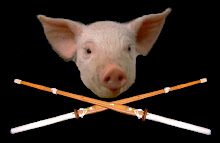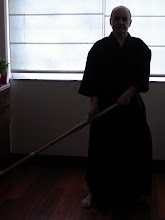ETIQUETTE (REI-GI)
Rei-Gi (manners)
is perhaps the most important thing that kendo and iaido can teach us, and it
coincides with traditions of old. Simply
showing respect and courtesy in all you do will help you grow as person
throughout your life. Learn it and live
it.
THE DOJO:
When entering the
dojo, remove your shoes and place them outside the door in an orderly
fashion. After entering the dojo,
politely bow to show respect. Generally,
the bow can be directed at the front of the dojo or to Sensei.
After you bow,
find your place along the outer portion of the dojo and place your gear in an
orderly fashion. Generally, seating will
follow a progression from highest rank to lowest rank or least tenure in the
class. Remember to respect your gear and
your swords; even the shinai should be considered a sword and placed carefully
upon the ground and carried in an appropriate manner.
As a beginning
student, you will often be asked to help with tasks such as cleaning the dojo,
sweeping the floors, setting up chairs, etc.
It is important to be on-time and ready to go at the scheduled class
time, so these tasks should be performed in a manner to permit class to start
on-time. Once these tasks are complete,
all students should be dressed and ready to go.
PRACTICE (KEIKO):
Our classes
typically begin with the study of iaido, the way of drawing the sword, and
prior to kendo. As a member, you are not
required to study both kendo and iaido, you may choose either. It is, however, recommended that you study both,
as they will only enhance your learning and are complimentary in nature.
It is customary to
join the lineup at the beginning and at the end of the practice, sitting on the
left hand side of the person who has a higher grade or more tenure than you. The command Seiretsu (Line Up) will be given,
followed by the commands to bow (Rei) and to start practice (Keiko). If you study iaido as well as kendo, we will
lineup to perform stretching and basic warm-ups to begin the class. When in doubt, follow a student with
experience in the progression of things.
Sensei will then discuss practice or announcements are
made (while in seiza), followed by a command signaling the end of class (dismissed). If you would like to thank someone who was
particularly helpful to you during the class, please do so after finishing the
session.
During Sunday’s
class, Kendo Kata will commence after iaido.
Kendo kata is a fundamental study of the basics of kendo and is an
important part of learning the way of the sword.
Your advancement
in kendo and iaido is shown by your movement, behavior, appearance, and
attitude, and this begins before you enter the dojo. Other students, both higher and lower in rank
or grade, will judge you on these principles and learn from your example.





No hay comentarios:
Publicar un comentario